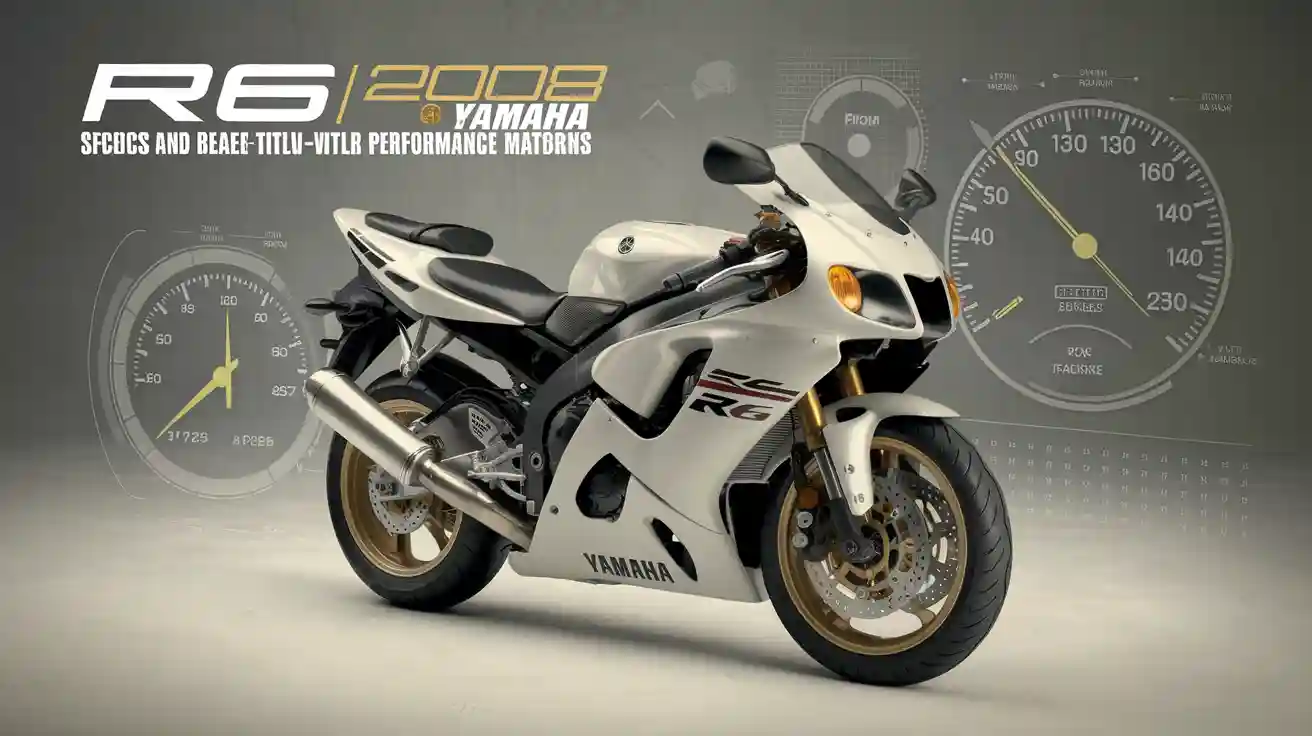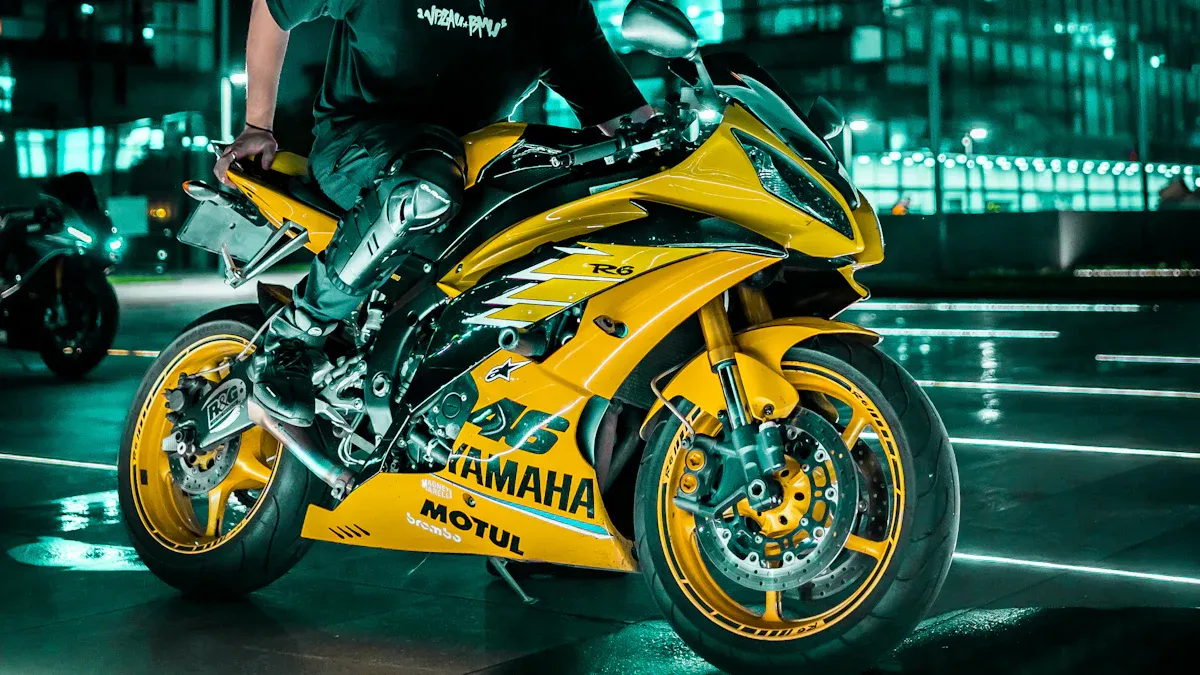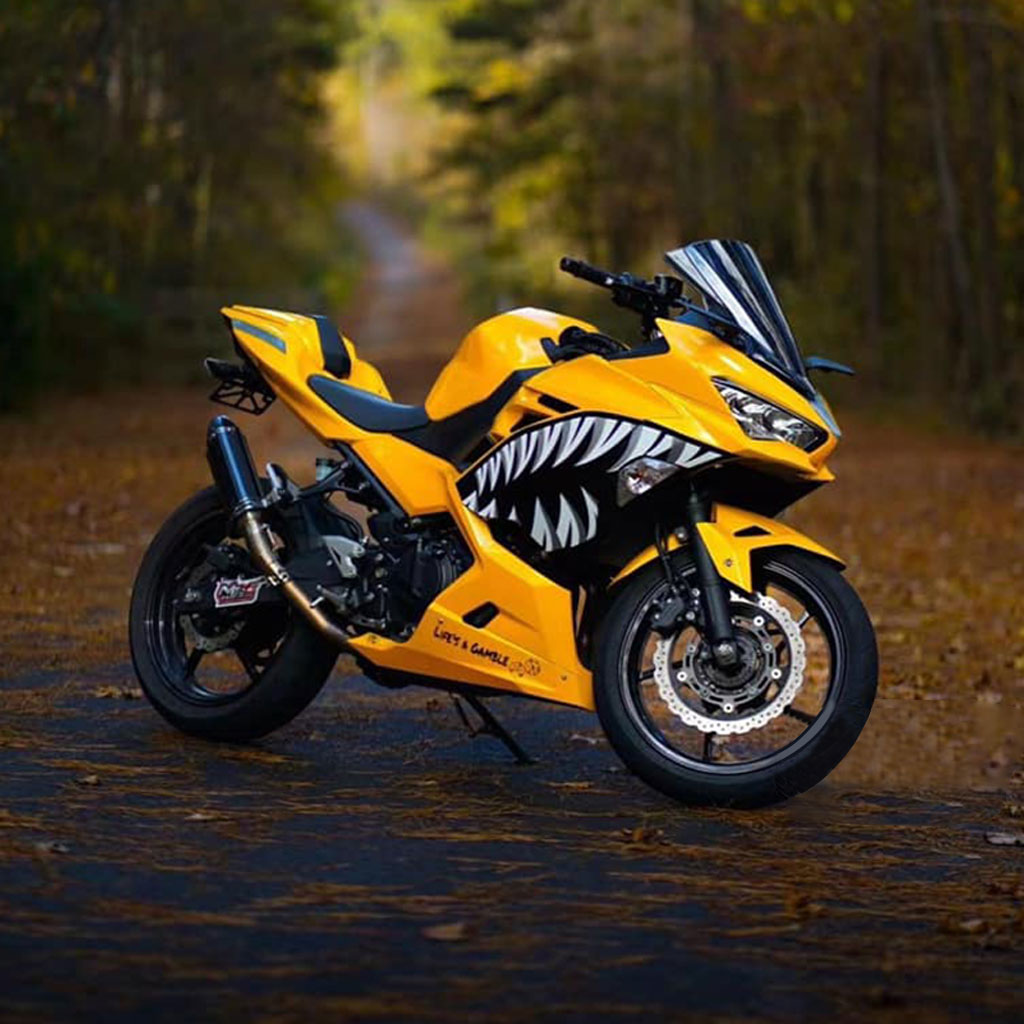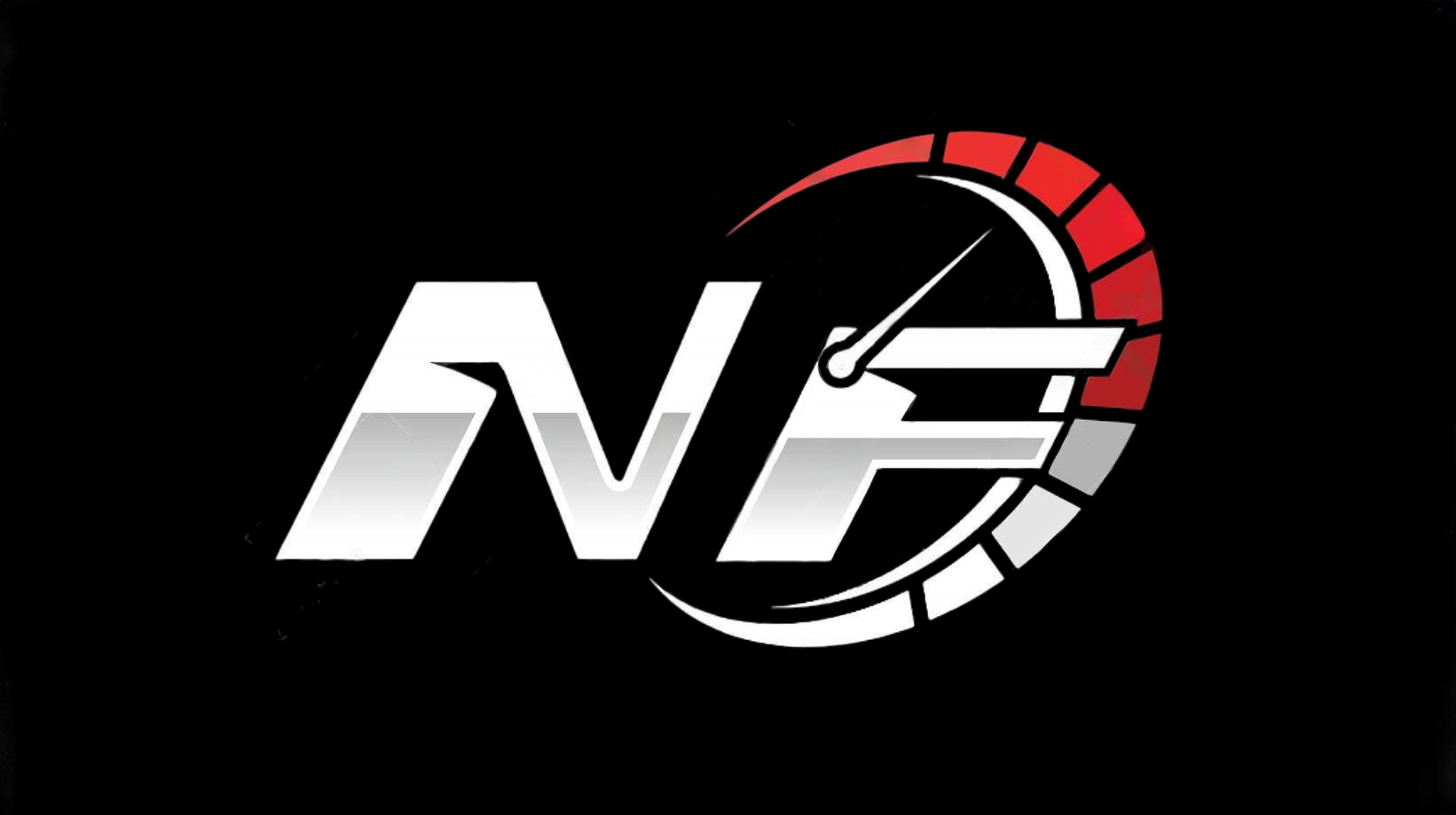R6 2008 Yamaha Specs and Real-World Performance Analysis

The r6 2008 yamaha stands out in its class with a high-revving engine, sharp handling, and race-inspired technology. Riders notice the difference when they compare its lightweight frame and advanced suspension to other sportbikes. The r6 gained attention for its strong market presence—sales rose by 44% since 2001, and the 600cc segment now makes up more than half of yamaha's supersport sales. The table below shows the most notable technical specifications that set the yzf-r6 apart:
| Specification Category | 2008 Yamaha YZF-R6 Highlights |
|---|---|
| Engine | 599cc liquid-cooled, DOHC, 16-valve inline-4, 13.1:1 compression ratio, fuel injected |
| Transmission | 6-speed manual, slipper clutch included |
| Suspension | Fully adjustable inverted front forks and twin-sided aluminum swing arm rear suspension |
| Brakes | Dual 310mm hydraulic front discs, single 220mm hydraulic rear disc |
| Frame | Lightweight aluminum/magnesium alloy |
| Tires | Dunlop tubeless, 120/70 ZR17 front, 180/55 ZR17 rear |
| Weight | Dry weight 366 lbs (166 kg), competitive for class |
| Performance | High-revving engine up to 16,500 rpm, track-ready handling and sharp cornering |
| Features | Lap timer, adjustable shift light, digital instrumentation, race-oriented design |
| MSRP | $9,599 (2008) |
Riders should consider the r6 2008 yamaha for its reputation, proven reliability, and potential for upgrades. The r6 remains a top choice for anyone seeking a blend of performance and daily usability.
2008 Yamaha YZF-R6 Technical Specifications

YZF-R6 Engine and Power
The 2008 yamaha yzf-r6 features a compact and powerful engine that sets it apart in the supersport category. Yamaha engineers designed the engine to deliver high-revving performance and quick throttle response. Riders experience a thrilling rush as the r6 climbs toward its redline. The engine specs highlight the advanced technology packed into this machine.
| Specification | Detail |
|---|---|
| Engine Displacement | 599 cc |
| Peak Horsepower | 123.7 ps (approx. 122 bhp) @ 14,000 rpm |
| Peak Torque | 6.65 kgf·m (65.2 N·m) @ 11,000 rpm |
| Bore | 67 mm |
| Stroke | 42.5 mm |
| Compression Ratio | 13.1 |
| Engine Type | Water-cooled, 4-stroke, DOHC, 4 Valve |
The r6 engine uses a high compression ratio and a short-stroke design. This combination allows the engine to rev quickly and produce strong power at high rpm. Riders notice the sharp response and impressive acceleration, especially when the tachometer sweeps past 10,000 rpm. The exhaust system complements the engine by reducing weight and improving flow, which helps maximize power output. The r6 2008 yamaha stands out for its ability to deliver both everyday usability and track-ready horsepower.
R6 2008 Yamaha Chassis and Frame
Yamaha built the r6 chassis with a focus on light and agile handling. The frame uses a mix of aluminum castings and pressed plates, which keeps the weight low and the structure strong. The Deltabox frame design, inspired by MotoGP technology, places the top spars close to the torsional axis. This approach improves rigidity and allows the r6 to respond quickly to rider input.
| Component | Materials Used | Design Features and Notes |
|---|---|---|
| Frame | Aluminum (revised mold castings and pressed plates) | Compact, lightweight Deltabox; MotoGP-inspired 'straight frame concept'; engine as fully stressed member; optimized rigidity for agile handling |
| Rear Subframe | Detachable magnesium | Reduces weight; easy access for maintenance; cost-effective replacement |
| Swingarm | Aluminum (castings and pressed plates) | Lightweight 'gull wing' type; revised pivot area for increased rigidity; reduces squat from chain reaction |
The magnesium rear subframe concentrates mass toward the center of the bike. This design choice improves stability and sport riding performance. The engine acts as a stressed member, which means it supports part of the frame's load. This setup reduces overall weight and increases strength. The exhaust system tucks in tightly, further centralizing mass and helping the r6 feel nimble in corners.
Suspension and Handling of the 2008 Yamaha YZF-R6
The suspension system on the yzf-r6 uses advanced components to deliver precise control. Yamaha equipped the front with a fully adjustable 41 mm inverted cartridge fork. The rear uses an adjustable link-type monocross absorber. Both ends offer 4.7 inches (120 mm) of travel, which gives the r6 a firm and responsive ride.
| Suspension Component | Description |
|---|---|
| Front Suspension | Fully adjustable 41 mm inverted cartridge fork with 4.7 inches (120 mm) of travel, providing ultra-precise feedback |
| Rear Suspension | Adjustable link-type monocross absorber with 4.7 inches (120 mm) of travel |
The r6 suspension feels stiff and track-oriented. Riders notice a harsher ride over bumps and rough roads. Selecting the correct spring rate is important. A spring that is too soft may bottom out, while the right spring improves smoothness and keeps the tires in contact with the road. Even with upgrades, the suspension remains firm compared to other motorcycles. However, this setup gives the r6 its famous light and agile handling. The bike holds a line through corners and responds instantly to steering input. Riders who want more comfort can tune the suspension or install aftermarket parts, but the r6 always prioritizes sharp cornering and stability.
Tip: Riders who plan to use the r6 for daily commuting may want to adjust the suspension for a softer ride. Those who ride on the track will benefit from the stock setup's precision and control.
R6 Brakes and Safety Features
Yamaha designed the r6 with advanced braking components to ensure strong stopping power and rider confidence. The front wheel uses dual 310 mm hydraulic discs, while the rear wheel features a single 220 mm disc. These large discs help the r6 stop quickly and safely, even at high speeds. The calipers grip the discs firmly, which improves braking performance and reduces stopping distances.
The r6 includes a radial master cylinder for the front brakes. This design gives the rider better control and a more direct feel at the lever. Riders can modulate the brakes easily, which helps them avoid locking the wheels during sudden stops. The tyres play a key role in safety, as they provide the grip needed for effective braking. Yamaha fits the r6 with high-quality Dunlop tyres that stick well to the road, especially during aggressive riding.
Safety features on the r6 focus on giving the rider control and feedback. The bike does not have ABS, but the strong brakes and sticky tyres help compensate. The chassis and suspension keep the bike stable under hard braking, which prevents the rear wheel from lifting. Riders appreciate the predictable feel of the brakes, especially when riding on twisty roads or at the track.
Note: Regular inspection of the brake pads, discs, and tyres is important for maintaining safe operation. Worn tyres or pads can reduce braking effectiveness and increase stopping distances.
YZF-R6 Dimensions and Weight
The 2008 Yamaha YZF-R6 has a compact and lightweight design. These dimensions make the bike easy to handle and quick to respond to rider input. The table below shows the official measurements for the yzf-r6:
| Specification | Value |
|---|---|
| Length (mm) | 2040 |
| Width (mm) | 705 |
| Height (mm) | 1100 |
| Dry Weight (kg) | 166 |
| Curb Weight (kg) | 188 |
The r6 stands out in its class because of its low weight and narrow profile. Riders notice the difference when they lean into corners or change direction quickly. The following points explain how the r6's dimensions and weight affect its performance:
- The r6 weighs 419 pounds, which is lighter than the Kawasaki ZX-6R. This lower weight makes the r6 feel nimble and easy to maneuver.
- The shorter wheelbase and steeper rake help the r6 turn quickly. Riders can flick the bike from side to side with little effort.
- The narrow width and tall seat height create an aggressive riding position. This setup improves handling and lets riders shift their weight easily.
- Many riders say the r6 feels quick and responsive in corners. Racers prefer this nimble feel for track use.
- The lightweight chassis and strong engine work together to deliver sharp acceleration and fast corner exits.
- The r6 uses stiff suspension, which supports precise handling but can feel less comfortable on rough roads.
- The tyres provide the grip needed for quick changes in direction and stable cornering.
The r6's dimensions and weight give it a unique character. Riders who want a bike that feels light and agile will enjoy the r6. The tyres, suspension, and chassis all work together to create a machine that excels in both street and track environments.
R6 2008 Yamaha Real-World Performance
Daily Riding Experience with the 2008 Yamaha YZF-R6
Riders who use the r6 for daily commuting notice its sharp handling and lightweight feel. The bike responds quickly to steering input, making it easy to maneuver through city streets. The chassis design helps reduce the effect of braking, so the r6 stays stable even in sudden stops. Many riders enjoy the confidence this gives them in traffic.
The r6 2008 yamaha offers a docile ride below 4000 rpm. This makes it possible to handle stop-and-go traffic and rough roads. However, the bike generates noticeable heat near the rider’s legs, especially when waiting at traffic lights. The seat and rear section provide minimal comfort for passengers, so most riders use the r6 solo.
The following table highlights the strengths and weaknesses of the 2008 Yamaha YZF-R6 in both urban and highway environments:
| Aspect | Strengths | Weaknesses |
|---|---|---|
| Handling | Razor-sharp, crisp, best-in-class 600cc handling; chassis reduces braking effect; super agile yet stable and confident in fast turns | N/A |
| Engine | High-revving up to 15,800 rpm; updated higher compression ratio (13.1:1); phenomenal performance beyond 9000 rpm; more usable mid-range than predecessors | Limp and lackluster low-end power, making it less suitable for stop-and-go urban traffic |
| Urban Riding | Docile below 4000 rpm; can survive stop-go traffic and poor roads | Generates significant heat towards rider's legs at traffic lights; uncomfortable in traffic; no fuel gauge; spongy brakes due to rubber lines in hot climates |
| Pillion Comfort | N/A | Minimal pillion comfort; rear seat not well cushioned for touring |
| Touring/Highway | Usable mid-range; tank range of 200-230 km; suitable for spirited riding and touring with luggage options; relatively comfortable riding position | Seat not cushioned for long touring; suspension preload adjustable but limited damping adjustability |
| Maintenance | Easy to service with accessible body panels; good build quality and fit and finish | No braided brake lines (OEM rubber lines spongy in heat) |
| Customization | Mechanical ride height adjustment available front and rear via OEM parts | N/A |
Note: Riders who plan to use the r6 for city commuting should prepare for heat buildup and a firm ride. The lack of a fuel gauge may require more frequent fuel checks.
Track and Sport Performance of the R6
The r6 shines on the racetrack. Its chassis and suspension deliver precise control at high speeds. Riders experience stable cornering and quick direction changes. The tyres provide excellent grip, allowing the bike to hold a line through fast turns.
Professional testing at Phillip Island in 2008 showed the r6’s true potential. Broc Parkes, a professional rider, set a fastest lap time of 1'4.6, beating his closest competitor by 0.4 seconds and breaking previous records. His teammate, Fabien Foret, improved his times throughout the test, reaching a best of 1'5.2. These results came from optimizing suspension settings under changing track conditions, including higher temperatures and a bumpier surface. The r6’s performance on the track demonstrates its ability to compete at the highest level.
Riders who take the r6 to track days or spirited rides on twisty roads benefit from its high-revving engine and agile frame. The bike feels stable at speed and inspires confidence in corners. The suspension, while stiff for daily use, becomes an asset on smooth pavement. The r6 rewards skilled riders with fast lap times and a thrilling experience.
Fuel Efficiency and Maintenance for the YZF-R6
The yzf-r6 offers a tank range of 200 to 230 kilometers, which suits both city and highway riding. Riders who keep the rpm low can stretch fuel efficiency, but aggressive riding reduces range. The lack of a fuel gauge means riders must track mileage carefully.
Maintenance on the r6 is straightforward. Yamaha designed the body panels for easy removal, so routine service tasks like oil changes and air filter replacements take less time. The build quality and fit of the parts help the bike last longer with regular care. However, the stock rubber brake lines can feel spongy in hot weather, so many owners upgrade to braided lines for better brake feel.
Tip: Regularly check tyre pressure and brake pad wear to maintain peak performance and safety. Keeping up with scheduled maintenance helps the r6 stay reliable for years.
Owner and Rider Impressions of the 2008 Yamaha R6
Many owners describe the r6 as a motorcycle that feels alive on every ride. Riders often mention the sharp handling and quick response. The bike changes direction with little effort. This makes it popular with both new and experienced sportbike fans.
What Owners Like Most
- Handling: Riders praise the r6 for its agility. The bike feels light and stable in corners. Many say it inspires confidence on twisty roads.
- Engine Character: Owners enjoy the high-revving nature of the engine. The power comes alive above 10,000 rpm. This gives a thrilling rush during spirited rides.
- Build Quality: Many riders note the solid construction. The fit and finish of the bodywork impresses owners. The controls feel precise and durable.
- Track Capability: Riders who visit the track say the r6 stands out. The suspension and brakes work well at high speeds. The bike holds a line and feels planted in fast turns.
Common Complaints
- Comfort: Some owners find the seat too firm for long rides. The riding position feels aggressive. This can cause discomfort during daily commutes.
- Low-End Power: Riders notice a lack of power at low rpm. The engine feels weak below 6,000 rpm. This makes city riding less enjoyable for some.
- Heat: Many owners report heat from the engine. The bike gets warm in traffic. This can bother riders during summer months.
- No Fuel Gauge: Some riders wish for a fuel gauge. They must track mileage to avoid running out of gas.
Rider Quotes
"The r6 rewards you when you push it hard. It feels like a race bike for the street."
— Alex, owner from California
"I love how the r6 handles. It leans into corners with ease and feels stable at speed."
— Jamie, rider from Texas
"The seat is not comfortable for long trips, but the fun factor makes up for it."
— Priya, owner from Florida
Owner Satisfaction Table
| Feature | Owner Rating (out of 5) | Common Comments |
|---|---|---|
| Handling | 5 | Agile, sharp, confidence-inspiring |
| Engine | 4 | Exciting at high rpm, weak at low rpm |
| Comfort | 3 | Firm seat, aggressive position |
| Reliability | 4 | Few mechanical issues, solid build |
| Track Use | 5 | Excellent for track days |
Summary of Impressions
Most owners agree that the r6 2008 yamaha delivers a unique riding experience. The bike excels on twisty roads and racetracks. Riders who value sharp handling and high-revving power enjoy this model the most. Some owners suggest upgrades for comfort or city use. The r6 remains a favorite among sportbike fans for its blend of excitement and reliability.
R6 2008 Yamaha Fairing and Performance Upgrades

Common Fairing Upgrades for the 2008 Yamaha YZF-R6
Many riders choose to upgrade the fairings on their r6. These upgrades can improve both the look and function of the motorcycle. Some riders pick lightweight race fairings made from fiberglass. These fairings reduce weight and help the bike handle better on the track. Others select custom-painted fairings to give their r6 a unique style. Quick-release fasteners make it easier to remove fairings for maintenance.
Popular fairing upgrades include:
- Fiberglass or carbon fiber race fairings
- Custom graphics or paint kits
- Double bubble windshields for better wind protection
- Frame sliders that protect the fairings during a fall
Riders often say that upgraded fairings make the r6 look more aggressive and help with aerodynamics.
Performance Parts and Modifications for the R6
Owners of the r6 often install performance parts to boost speed and power. The most common upgrade is the exhaust. Many choose a full race system to replace the stock exhaust. This change can increase horsepower and reduce weight. Some riders pick an aftermarket exhaust for a deeper sound and better airflow.
Other popular modifications include:
- High-flow air filters for better engine breathing
- Power commanders to adjust fuel mapping
- Upgraded brake pads for stronger stopping power
A table below shows common upgrades and their benefits:
| Upgrade | Benefit |
|---|---|
| Full race system | More power, less weight |
| Aftermarket exhaust | Improved sound, better flow |
| High-flow air filter | Increased engine efficiency |
Impact of Upgrades on Handling and Comfort
Upgrades can change how the r6 feels on the road. Lighter fairings and a new exhaust can make the bike easier to handle. Riders notice quicker turns and better acceleration. Some modifications, like a full race system, may make the bike louder. This can affect comfort on long rides.
Tip: Riders should balance performance gains with comfort. Not all upgrades suit daily riding.
Many riders find that the right upgrades make the yamaha r6 more enjoyable. They get a bike that looks sharp, sounds better, and feels faster.
Cost and Installation Considerations for YZF-R6 Upgrades
Upgrading a 2008 Yamaha YZF-R6 can improve performance and style, but riders should plan for both cost and installation. Each upgrade comes with its own price range and level of difficulty. Some parts, like fairings or exhaust systems, may require special tools or professional help.
Typical Costs for Popular Upgrades:
| Upgrade Type | Estimated Cost (USD) | Installation Difficulty |
|---|---|---|
| Race Fairings | $300 - $800 | Moderate |
| Aftermarket Exhaust | $400 - $1,200 | Moderate to High |
| High-Flow Air Filter | $50 - $120 | Easy |
| Power Commander | $250 - $400 | Moderate |
| Upgraded Brake Pads | $40 - $150 | Easy |
| Braided Brake Lines | $80 - $200 | Moderate |
Many riders choose to install simple upgrades at home. Air filters and brake pads often take less than an hour. More complex parts, such as a full exhaust or race fairings, may need a mechanic. Labor costs can add $100 to $300, depending on the shop and the job.
Tip: Riders should always check the warranty before making changes. Some upgrades can void factory coverage.
Installation time depends on skill and available tools. Beginners may need to watch video guides or read manuals. Shops often finish upgrades faster, but this adds to the total cost.
A careful plan helps avoid surprises. Riders should set a budget for both parts and labor. They should also consider the long-term value. Quality upgrades can make the r6 more enjoyable and may increase resale value.
Choosing the 2008 Yamaha YZF-R6
Who Should Consider the R6 2008 Yamaha
The 2008 R6 attracts riders who want a sportbike with sharp handling and strong performance. This motorcycle suits people who enjoy spirited rides on twisty roads or track days. Riders with some experience will feel confident because the bike responds quickly to input. Those who value a lightweight frame and a race-inspired design often choose this model. The R6 also appeals to riders who want a reliable machine that holds up well over time. People who plan to upgrade their bike with custom parts or fairings will find many options for this model.
Key Pros and Cons of the 2008 Yamaha YZF-R6
Motorcycle reviewers and owners have shared many opinions about the 2008 R6. The following lists highlight the most important strengths and weaknesses:
Pros:
- Comfortable yet aggressive riding position
- Excellent wind protection and clear visibility
- Light and slender frame for great control
- Powerful engine with a unique induction sound
- High build quality and durable finish
- Maintains condition well, even after hard use
- Upgraded tires improve grip and confidence
- Aftermarket exhausts boost sound and performance
- Modifications like crash protection and adjustable levers enhance ride quality
- Comfortable for highway cruising
Cons:
- Stiff suspension can feel bumpy on rough roads
- Comfort is best at slow or fast speeds, less so in the middle range
- Standard tires wear quickly and offer less grip
- Stock exhaust may need upgrading for better sound
- Fairings are delicate and scratch easily
- Some riders find it too focused on track performance for daily use
Tip: Riders can address many cons with simple upgrades, such as better tires or crash protection.
Tips for Buying a Used YZF-R6
When shopping for a used 2008 R6, buyers should check the bike’s condition carefully. Look for signs of wear on the fairings and inspect for scratches or cracks. Test the suspension to make sure it feels smooth and not overly stiff. Ask about any upgrades, such as new tires or an aftermarket exhaust. Check the service history to confirm regular maintenance. Buyers should also listen for unusual engine noises and test all controls. A well-maintained R6 will offer years of reliable riding.
| Checklist for Buyers | What to Look For |
|---|---|
| Fairing and bodywork | Scratches, cracks, or repairs |
| Suspension and tires | Smooth action, good tread |
| Engine and exhaust | Clean sound, no leaks |
| Service records | Regular oil changes, inspections |
| Upgrades and modifications | Quality parts, professional fit |
Yamaha designed the 2008 YZF-R6 for riders who want sharp handling and strong acceleration. Owners often upgrade fairings and parts to improve both style and performance. Riders should check the bike’s condition before buying and plan upgrades based on their needs.
Choosing quality parts and regular maintenance helps keep the motorcycle reliable and fun to ride.
FAQ
What makes the 2008 Yamaha YZF-R6 engine unique?
The 2008 R6 engine uses a high compression ratio and a short-stroke design. This setup allows the engine to rev higher and deliver strong power at high rpm. Riders experience quick acceleration and a thrilling ride.
Can beginners handle the 2008 Yamaha YZF-R6?
Most beginners find the R6 challenging. The bike has a sharp throttle response and an aggressive riding position. Riders with some experience adapt more easily. Safety gear and proper training help new riders gain confidence.
How often should owners service the R6?
Yamaha recommends oil changes every 3,000 miles. Owners should check the chain, brakes, and tires regularly. Scheduled maintenance keeps the bike reliable and safe. A service manual provides detailed intervals for each part.
What upgrades improve comfort for daily riding?
Many riders install a softer seat or adjustable levers. Some choose aftermarket windshields for better wind protection. Suspension tuning also helps. These upgrades make daily rides more comfortable.
Does the 2008 R6 have any common issues?
Some owners report heat near the legs and a firm seat. The lack of a fuel gauge surprises many riders. Regular maintenance and simple upgrades address most concerns.
Tip: Riders should check the bike’s condition before buying and plan upgrades based on their needs.
See Also
2025 Yamaha R3 Price Analysis And Market Overview
Key Features That Make The 2025 Yamaha R7 Unique
Top Yamaha R6 Fairing Kits Reviewed For Style And Performance

